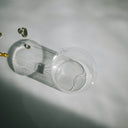Hair loss is a deeply personal experience that can trigger anxiety, especially when its cause is unknown. While often linked to genetics, stress, or hormonal changes, many wonder if sudden or severe shedding might signal something more sinister—like cancer. This concern is understandable, given cancer’s reputation for varied and unpredictable symptoms. In this article, we’ll separate fact from fear, exploring when hair loss could be cancer-related and when it’s likely due to other factors.
Table of content
Can Hair Loss Be a Sign of Cancer?
Hair loss is rarely a direct sign of cancer, but it can occur indirectly due to cancer treatments or certain paraneoplastic syndromes. Most cancers do not cause hair loss on their own. However, chemotherapy, radiation, and rare immune reactions to tumors (paraneoplastic syndromes) can lead to shedding. Sudden, patchy, or unexplained hair loss should always be evaluated by a doctor to rule out underlying conditions, including cancer.
As your leading source for hair health information over the past 4 years, we never compromise on accuracy. When it comes to your health, you deserve information you can truly rely on - and earning your trust is our top priority.
Here's how Scandinavian Biolabs ensures every piece of content meets the highest standards of accuracy and integrity:
- Credentialed Experts: Our reviewers are actively practicing doctors and medical researchers
- Stringent Reviews: Content undergoes rigorous editing by subject specialists and review by a practicing doctor.
- Evidence-Based: We rely on well-established research from trusted scientific sources like peer-reviewed journals and health authorities.
- Full Transparency: Our editorial standards, writer credentials, reviewer credentials, correction process, and funding are all publicly documented.
- Independent Voice: While we do promote products, we operate in a vacuum to business operations. Our main goal is just an unwavering commitment to providing medically-sound guidance.
You can count on Scandinavian Biolabs to consistently deliver the trustworthy health information you deserve. Read our Editorial Standards.
Understanding the Hair Loss-Cancer Connection
1. Cancer Treatments: The Primary Culprit
Hair loss is most commonly tied to cancer therapies rather than the disease itself:
- Chemotherapy: Targets rapidly dividing cells, including hair follicles. Up to 65% of patients experience chemo-induced alopecia, often starting 2–4 weeks after treatment.
- Radiation Therapy: Causes localized hair loss in treated areas (e.g., scalp, face).
- Immunotherapy/Targeted Drugs: Drugs like taxanes or EGFR inhibitors may thin hair or alter texture.
2. Paraneoplastic Syndromes
In rare cases (less than 1%), cancers trigger immune responses that attack hair follicles. Examples include:
- Alopecia Neoplastica: Metastatic cancer cells invade the scalp, causing patchy loss. Seen in breast, lung, or kidney cancers.
- Paraneoplastic Pemphigus: Autoimmune blistering disorder linked to lymphomas or leukemias, leading to scarring alopecia.
3. Hormonal or Metabolic Disruption
Cancers affecting hormone-producing organs (e.g., thyroid, adrenal glands) may indirectly cause hair loss by altering:
- Thyroid hormone levels
- Cortisol production
- Estrogen/testosterone balance
Cancers More Commonly Associated With Hair Loss
1. Breast Cancer
While breast cancer itself doesn’t cause hair loss, treatments like doxorubicin or cyclophosphamide often result in total scalp hair loss. Hormone therapies (e.g., tamoxifen) may also thin hair.
2. Lymphoma
Lymphomas can trigger paraneoplastic alopecia areata, an autoimmune reaction causing patchy loss. A 2018 JAMA Dermatology study noted hair regrowth in 70% of patients after lymphoma treatment.
3. Ovarian/Testicular Cancer
These cancers may alter androgen levels, potentially accelerating pattern baldness in genetically predisposed individuals.
4. Skin Cancer
Basal or squamous cell carcinomas on the scalp can destroy hair follicles locally. Melanoma rarely causes hair loss unless metastatic.
Red Flags: When Hair Loss Warrants Cancer Screening
Consider consulting a doctor if hair loss accompanies:
- Unexplained weight loss (>10 lbs in a month)
- Persistent fatigue or night sweats
- Lumps/swollen lymph nodes
- Unusual bleeding or skin changes
Diagnosing the Cause of Hair Loss
1. Medical History & Physical Exam
Doctors assess:
- Pattern of loss (diffuse vs. patchy)
- Scalp health (scaling, inflammation)
- Family history of cancer or autoimmune disease
2. Blood Tests
- Complete blood count (CBC)
- Thyroid panel
- Iron, vitamin D, and hormone levels
3. Imaging & Biopsies
If cancer is suspected:
- Scalp Biopsy: Checks for metastatic cells or scarring alopecia.
- CT/PET Scans: Detect tumors in other organs.
Managing Cancer-Related Hair Loss
During Treatment
- Scalp Cooling Caps: Reduce chemo-induced alopecia by 50% in some patients.
- Gentle Hair Care: Use sulfate-free shampoos and soft brushes.
- Wigs/Headwear: Medicare often covers wigs post-cancer diagnosis.
Post-Treatment Regrowth
Hair typically regrows 3–6 months after chemo ends, though texture/color may change initially. Support growth with:
- Minoxidil 2% (approved for post-chemo regrowth)
- Biotin and collagen supplements
- Low-level laser therapy (LLLT)
Myths About Hair Loss and Cancer
Myth 1: “Only Advanced Cancer Causes Hair Loss”
Truth: Treatment-related shedding occurs at any stage. Paraneoplastic hair loss is rare and not stage-dependent.
Myth 2: “Natural Hair Loss = High Cancer Risk”
Truth: Androgenetic alopecia (common baldness) isn’t linked to higher cancer rates.
Myth 3: “Hair Regrowth Means Cancer Is Gone”
Truth: Regrowth after chemo reflects follicle recovery, not necessarily cancer remission.
When to Seek Immediate Help
Sudden hair loss with these symptoms requires urgent care:
- Neurological issues (seizures, vision loss)
- Difficulty breathing or chest pain
- Severe abdominal swelling
Key Takeaways
- Hair loss is seldom a direct cancer symptom but often results from treatments.
- Paraneoplastic syndromes causing hair loss are extremely rare.
- Unexplained shedding plus systemic symptoms warrants medical evaluation.
Conclusion
While hair loss alone is unlikely to signal cancer, it’s a valuable clue when paired with other warning signs. For those undergoing cancer treatment, shedding is usually temporary—a testament to the body’s resilience. If you’re experiencing mysterious hair loss, let it prompt a conversation with your doctor, not panic. With modern diagnostics and therapies, early detection and effective management are more achievable than ever.
Tired of Thinning Hair? Try a Clinically Tested Serum.
Looking for a natural way to regrow hair and achieve a thicker, fuller head of hair? Ditch the stinging nettle for hair loss – Bio-Pilixin Serum is a drug-free hair activation serum that delivers clinically tested results.
Here's why Bio-Pilixin is superior:
- Clinically Tested Results: 93% of users saw a reduction in hair loss, and 73% experienced increased hair density.
- Safe and Natural: Unlike harsh chemicals, Bio-Pilixin uses plant growth factors derived from stem cell technology to nourish hair follicles and stimulate growth.
- Fast-Acting: See visible results in as little as 45 days (most typically see results within 150 days).
Stop wasting time on unproven remedies. Bio-Pilixin is the safe, natural serum you've been searching for.
Read more:






